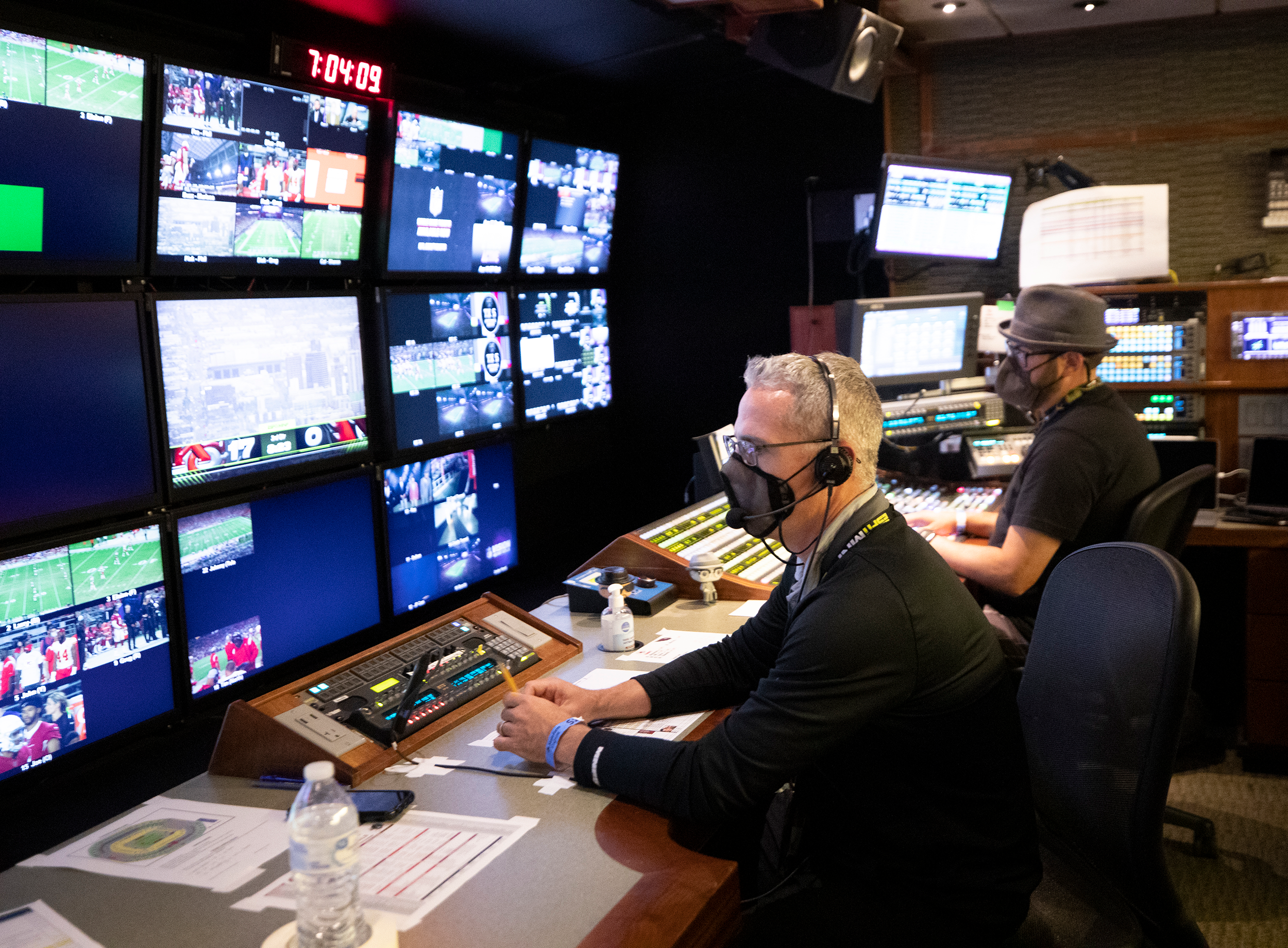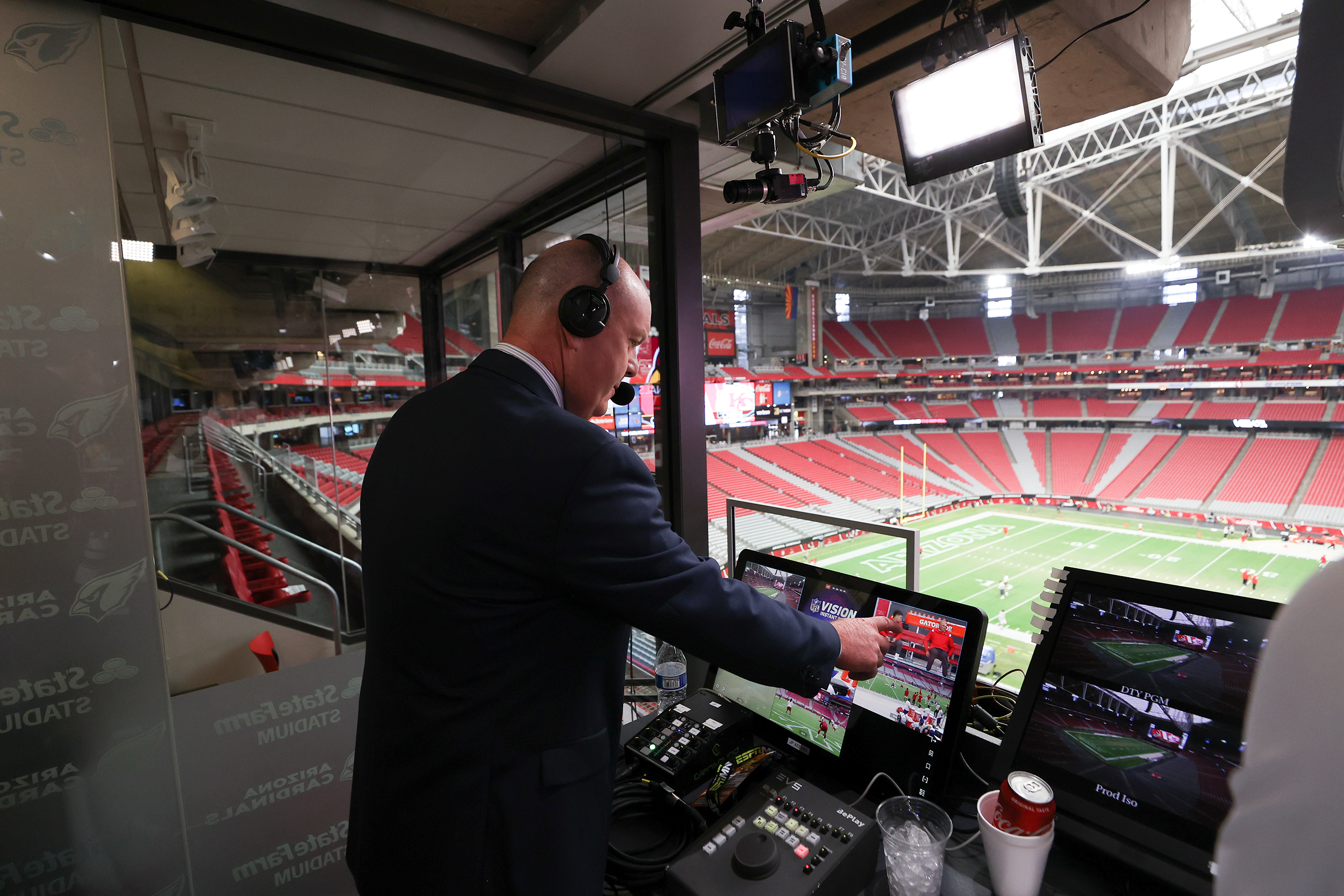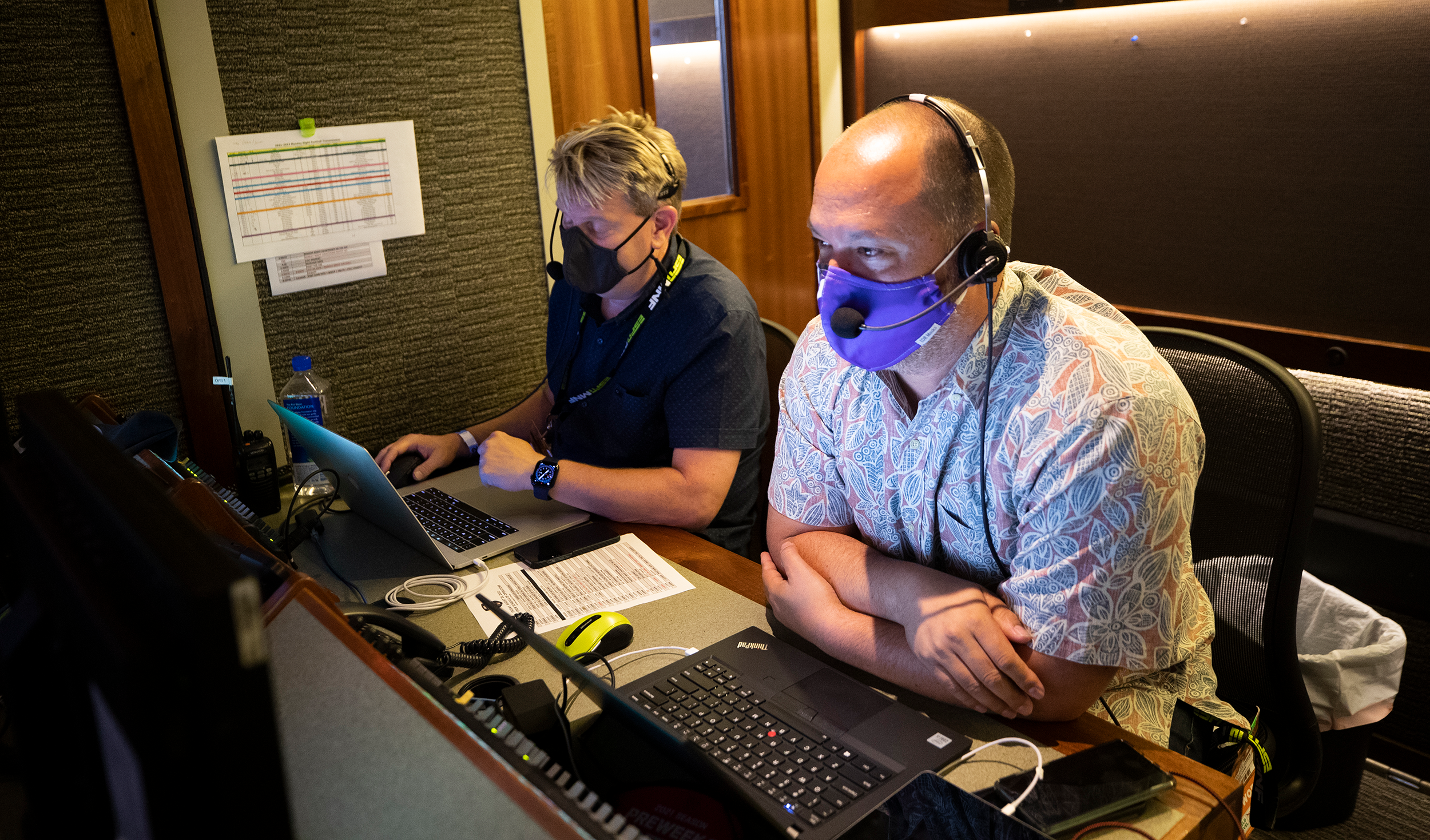ESPN Debuts On-Field Camera System for Monday Night Football With Sony FX-9 on ARRI Trinity Stabilizer
System is MNF’s more flexible answer to the shallow–depth-of-field craze
Story Highlights
Week 1 of the NFL season is nearly in the books, and, for those in the business of producing live football for television, a key conversation point is picking up right where it left off a season ago: what’s with this on-field camera shooting in a shallow depth of field?
It’s a trend that has swept the industry in 2021, and yesterday the shot was seen frequently across afternoon games on CBS and Fox.
With Monday Night Football returning this evening to kick off its 52nd season, ESPN is rolling out its own take on the new on-field camera, deploying a Sony FX-9 affixed to an ARRI Trinity camera-stabilization system.

Camera operator Clay Loveless (right) tinkers with the ARRI Trinity RF rig that he will operate this season on Monday Night Football for ESPN. (Photo: Gabriel Christus/ESPN Images)
The production crew expects the camera to serve many roles, from taking the place of the Steadicam to, when warranted, pulling in some of those popular cinematic looks.
“It’s basically a Steadicam Plus Plus,” says Monday Night Football director Jimmy Platt, who is entering his third season at the helm of the iconic sports-TV property. “It gives you the ability to have a jib and a Steadicam all in one system, essentially. Putting the shallow–depth-of-field camera on there is a plus, but we could have put any traditional broadcast camera on there.”
The shallow–depth-of-field camera caught fire last December, which, Platt notes, was too late for the Monday Night Football crew to work anything like it into their rotation. They did, however, have a lengthy offseason to weigh the options. He loved the image, but, as for many, the struggle to keep the image in focus was a sticking point he was hoping to overcome before committing to a camera of its like.
The NFL permits broadcast partners — ESPN included — only one roving camera position that can come onto the field during a stoppage in game action. ESPN didn’t want to sacrifice its valuable Steadicam without knowing that it would be logistically worth it. The ESPN operations team believes that this setup delivers the best of all worlds. The Sony FX-9 offers the strong autofocus needed to keep up with the goal of the shot, and the overall rig, which is connected to the truck via RF, offers more control over other elements of the image (such as aperture and color correction), making it a seamless and valuable addition to the broadcast.
“That [shallow depth of field] has taken on a life of its own, which has been cool to see,” says Platt. “There have been various success rates. We’ve had the benefit of being able to sit back and watch the development while also doing some of our own R&D. The thing that’s interesting with the shallow–depth-of-field craze is, there’s a reason it works in film; the sports world is a bit different. But there are use cases where shallow depth of field is great, like when a quarterback walks out onto the field or there’s a unique scene-setting shot.
“But, in a touchdown celebration,” he continues, “in my opinion, the rest of the environment is important. Only one or two players might be in focus, and the other players are out of focus, or the crowd is out of focus. What we’re going with gives us a really good use case in adjusting how much depth of field we have based on the situation at hand.

Director Jimmy Platt (left) and technical director Josh Miller rehearse at the front bench of ESPN Monday Night Football’s primary onsite mobile production unit, NEP EN1. (Photo: Gabriel Christus/ESPN Images)
“You have to look at this like a photographer,” Platt continues, “and actively choose when these types of shots will look great and when they will not. Can we get in and out of both looks within one system? I think this will help us do that well, which is what we saw when we tested it during the preseason. We’ll only get better at dialing it in. There’s still a lot of refinement that needs to be made that we’ll make as we go throughout the season.”
ESPN Senior Operations Producer Matthew Kwok says that the Monday Night Football team did extensive research over the summer in an attempt to vet the shallow–depth-of-field trend while simultaneously rethinking the on-field camera option as a whole. The team got its first look at the ARRI Trinity in action during a boxing event, and it caught their eye.
The camera, which will be operated on the field by veteran Monday Night Football Steadicam operator Clay Loveless, will present a new and significant challenge. Although a rig like this is used often in scripted film and television production, there’s a quite a difference, as Platt points out, between operating this unit during a take “on set” and operating it live “on the field” during a three-hour game in a football stadium, where there’s little control over the environment.
Another key decision in ESPN’s work with this camera was to stick with autofocus over putting manual controls into the hands of the operator or someone else. The added role of a focus puller (or assistant camera operator) was not suited to live sports production, in the team’s opinion.
“It’s hard for that focus puller to make refinements as the operator gets closer to the subject and vice versa,” Platt points out. “It ends up being a lot of hunting for the focus. With a normal broadcast camera, the Steadicam operator would be able to zoom and focus at the same time off of a grip switch. When you add in shallow depth of field, your room for error is minimal. They cannot zoom, get their camera moving, and focus like they normally would. You have to take that out of the picture, and that leaves you with one thing: autofocus.”
Both Platt and Kwok note that the autofocus features within Sony’s top line of cameras today, which includes the FX-9, are “really good” and helped make that an easier decision at the end of the day.
“I’m sure there’s going to be times when we are going to get burnt with it,” says Platt, “but I think that [those times] will be few and far between because of our ability to change the aperture level on the camera and know that, when we are in a certain use case and want to be in a lower or higher f-stop, we can be. The focal forgiveness is better depending on where your aperture is, and I think that’s going to be a big win in the ever changing landscape of this [trend].’
Replay Ops Get a Boost With EVS Xeebra
The ARRI-Sony unit is not the only new technical enhancement to keep an eye out for during this season of Monday Night Football. The engineering team has swapped out the camera on the SkyCam for a Sony P50, making it super-slo-mo–capable while retaining its ability to display the virtual line-to-gain graphics.

On-air officiating analyst John Parry will use EVS’s new Xeebra system to break down penalties and other key calls for Monday Night Football. (Photo: Gabriel Christus/ESPN Images)
On-air analysts, including replay official John Parry (who is back onsite this year after contributing remotely in 2020), will use the EVS Xeebra system in the booth for multi-camera review of replays.
Parry and a production spotter can roll through up to eight channels of replay feeds and be able to zoom in and cycle through the synchronized angles.
Game Operations Producer Dustin Epstein, Senior Operations Specialists James Munn and Joe Rainey, and Senior Operations Coordinator Kelsey Hahn all played key roles in the overall efforts onsite this year.
Some Crew Are OnSite, But Hybrid GREMI+ Model Remains
Last season, because of pre-vaccine COVID restrictions, Monday Night Football was produced via a workflow the network called “GREMI+.” This year’s efforts bring much of the crew back onsite while still deploying some of those methods. Four EVS operators will contribute from ESPN’s Bristol, CT, mothership, and a hybrid of graphics, scorebug, advanced telestration, and virtual graphics operations will be split between the site and Bristol.
ESPN Senior Operations Manager Steve Carter notes that last year’s restrictions certainly accelerated implementation of some of these workflows but that these are all methods that the crew has been discussing and looking to implement for the past few years.
He also points out that making the leap to JPEG 2000 for transmission with a supplement of fiber and satellite for transmission has helped make the workflow possible by reducing latencies across the board.
Return of Fans Gives Welcome Energy
This past weekend was another reflection of how valuable having fans in the stands is to the television product, with many NFL teams hosting spectators for the first time since 2019. ESPN Monday Night Football is the final of the major sports properties to welcome packed houses to its production, and the broadcaster gets to do the first game at Las Vegas’s Allegiant Stadium packed to the brim by Raider Nation.
Veteran sideline reporter Lisa Salters noted during a media conference call last week that something was lost when the Monday Night Football theme ended and wasn’t immediately followed by a huge roar from the crowd in a packed stadium. Platt agrees but also notes that it wasn’t an element that directly impacted him in the moment of doing his job of calling the shots.

Senior Operations Specialist James Munn (left) and Senior Operations Producer Matthew Kwok help oversee the efforts behind the scenes at ESPN Monday Night Football. (Photo: Gabriel Christus/ESPN Images)
“To be honest, when I’m in the moment and directing the show, I’m pretty emotionless,” says Platt, who became director of Monday Night Football in 2019. “I try not to get too high or swing too far one way, because I’ve found throughout my career that, if I get too amped up, I start going too fast, and that doesn’t translate into good TV.
“That being said,” he continues, “we did miss that third component of the game. The crowd really matters; the energy that it helps bring you or the disappointment that it can bring you. With helmets on [players], you can’t always see faces [well], but I can see [fans’ faces] in the crowd, and their smiles or disappointment help me tell the story sometimes better than a player or coach who may be more stoic can.”
While Monday Night Football was on hand to broadcast the first-ever home game for the newly minted Las Vegas Raiders last season in Week 2, that game was held without fans. So tonight’s season opener between the Raiders and the Ravens is effectively the first regular-season game in front of a packed house at the new Allegiant Stadium.
Tonight’s broadcast will effectively serve as another milestone for the league’s historic franchises. That will mean plenty of shots of the crowd, the stadium, and many of the sights and sounds of the newest home field in the NFL. Still, that factor is not one that Platt will let influence how he cuts the game.
“The game will dictate how many crowd shots we have when and where,” he says. “You have to go into every game without a set mindset of what you want to do. More so, you should let the game determine the story.”
Platt says the production team has talked through one scenario for handling the game: when the Raiders score their first touchdown in front of their home crowd. He notes the parties that it would be most important to capture then: Raiders owner Mark Davis, head coach Jon Gruden, the player who scored the touchdown, the stadium’s fan section affectionately referred to as “The Black Hole,” and the crowd as a whole.
“The hope is that, when they score that touchdown,” Platt says, “we don’t have to show a bunch of replays to determine if it was really a touchdown.”
Monday Night Countdown Gets Shallow–Depth-of-Field Rig of Its Own
Monday Night Football’s pregame show Monday Night Countdown also returns to the game site this year, having spent 2020 in a rooftop studio at ESPN’s Seaport Studios in New York City.
According to Operations Manager Mark Mignini, the show will be integrating its own shallow–depth-of-field rig, choosing, instead, to go the route of many other ESPN productions and placing a Sony A1 mirrorless camera on a MōVI stabilizing system.
Monday Night Countdown’s operations team of Operations Producers Gordon Reed and Johnathan Williams, Operations Specialist Claude Phipps, and Operations Coordinator Leah Morgenstern are part of a team of 30-35 ESPN full-timers and local utilities that make up the onsite crew.
Monday Night Countdown travels with two full sets for pre/postgame and halftime coverage across the ESPN family of networks. The primary set features a large, five-person desk bolted to a mobile stage and driven onto the field by golf carts. It can be struck and driven off the field in less than seven minutes, according to the operations team. The second desk is a small “bistro-style” desk that can easily be brought on and off the field at around the 20-yard line and is small and nimble enough to quickly be brought out for halftime.
The front bench, which includes show director Steve Zawilinski, is also back on the road, sharing the NEP EN1 facilities with the game crew.
The new season of Monday Night Football begins this evening with Monday Night Countdown from 6 to 8 p.m. ET. That’s followed by the debut of Monday Night Football with a matchup between the Baltimore Ravens and the Las Vegas Raiders beginning at 8 p.m. The game will be broadcast on ABC, ESPN, ESPN2, and ESPN Deportes and streamed on ESPN+.
